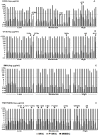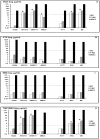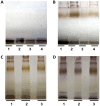Growing Burkholderia pseudomallei in biofilm stimulating conditions significantly induces antimicrobial resistance
- PMID: 20169199
- PMCID: PMC2820546
- DOI: 10.1371/journal.pone.0009196
Growing Burkholderia pseudomallei in biofilm stimulating conditions significantly induces antimicrobial resistance
Abstract
Background: Burkholderia pseudomallei, a gram-negative bacterium that causes melioidosis, was reported to produce biofilm. As the disease causes high relapse rate when compared to other bacterial infections, it therefore might be due to the reactivation of the biofilm forming bacteria which also provided resistance to antimicrobial agents. However, the mechanism on how biofilm can provide tolerance to antimicrobials is still unclear.
Methodology/principal findings: The change in resistance of B. pseudomallei to doxycycline, ceftazidime, imipenem, and trimethoprim/sulfamethoxazole during biofilm formation were measured as minimum biofilm elimination concentration (MBEC) in 50 soil and clinical isolates and also in capsule, flagellin, LPS and biofilm mutants. Almost all planktonic isolates were susceptible to all agents studied. In contrast, when they were grown in the condition that induced biofilm formation, they were markedly resistant to all antimicrobial agents even though the amount of biofilm production was not the same. The capsule and O-side chains of LPS mutants had no effect on biofilm formation whereas the flagellin-defective mutant markedly reduced in biofilm production. No alteration of LPS profiles was observed when susceptible form was changed to resistance. The higher amount of N-acyl homoserine lactones (AHLs) was detected in the high biofilm-producing isolates. Interestingly, the biofilm mutant which produced a very low amount of biofilm and was sensitive to antimicrobial agents significantly resisted those agents when grown in biofilm inducing condition.
Conclusions/significance: The possible drug resistance mechanism of biofilm mutants and other isolates is not by having biofilm but rather from some factors that up-regulated when biofilm formation genes were stimulated. The understanding of genes related to this situation may lead us to prevent B. pseudomallei biofilms leading to the relapse of melioidosis.
Conflict of interest statement
Figures




Similar articles
-
Impact of nutritional stress on drug susceptibility and biofilm structures of Burkholderia pseudomallei and Burkholderia thailandensis grown in static and microfluidic systems.PLoS One. 2018 Mar 26;13(3):e0194946. doi: 10.1371/journal.pone.0194946. eCollection 2018. PLoS One. 2018. PMID: 29579106 Free PMC article.
-
In vitro activities of amoxicillin-clavulanate, doxycycline, ceftazidime, imipenem, and trimethoprim-sulfamethoxazole against biofilm of Brazilian strains of Burkholderia pseudomallei.Antimicrob Agents Chemother. 2013 Nov;57(11):5771-3. doi: 10.1128/AAC.00721-13. Epub 2013 Sep 3. Antimicrob Agents Chemother. 2013. PMID: 24002089 Free PMC article.
-
Farnesol increases the susceptibility of Burkholderia pseudomallei biofilm to antimicrobials used to treat melioidosis.J Appl Microbiol. 2016 Mar;120(3):600-6. doi: 10.1111/jam.13027. J Appl Microbiol. 2016. PMID: 26669506
-
Biofilm Signaling, Composition and Regulation in Burkholderia pseudomallei.J Microbiol Biotechnol. 2023 Jan 28;33(1):15-27. doi: 10.4014/jmb.2207.07032. Epub 2022 Oct 17. J Microbiol Biotechnol. 2023. PMID: 36451302 Free PMC article. Review.
-
Burkholderia pseudomallei: the unbeatable foe?Southeast Asian J Trop Med Public Health. 1998 Jun;29(2):410-5. Southeast Asian J Trop Med Public Health. 1998. PMID: 9886137 Review.
Cited by
-
Pan-drug-resistant and biofilm-producing strain of Burkholderia pseudomallei: first report of melioidosis from a diabetic patient in Yogyakarta, Indonesia.Int Med Case Rep J. 2018 Nov 9;11:319-323. doi: 10.2147/IMCRJ.S173461. eCollection 2018. Int Med Case Rep J. 2018. PMID: 30519120 Free PMC article.
-
Temporal proteomic profiling reveals changes that support Burkholderia biofilms.Pathog Dis. 2019 Mar 1;77(2):ftz005. doi: 10.1093/femspd/ftz005. Pathog Dis. 2019. PMID: 30759239 Free PMC article.
-
Impact of nutritional stress on drug susceptibility and biofilm structures of Burkholderia pseudomallei and Burkholderia thailandensis grown in static and microfluidic systems.PLoS One. 2018 Mar 26;13(3):e0194946. doi: 10.1371/journal.pone.0194946. eCollection 2018. PLoS One. 2018. PMID: 29579106 Free PMC article.
-
Nitric oxide-dependent killing of aerobic, anaerobic and persistent Burkholderia pseudomallei.Nitric Oxide. 2012 Jun 30;27(1):25-31. doi: 10.1016/j.niox.2012.04.001. Epub 2012 Apr 10. Nitric Oxide. 2012. PMID: 22521523 Free PMC article.
-
Systematic mutagenesis of genes encoding predicted autotransported proteins of Burkholderia pseudomallei identifies factors mediating virulence in mice, net intracellular replication and a novel protein conferring serum resistance.PLoS One. 2015 Apr 1;10(4):e0121271. doi: 10.1371/journal.pone.0121271. eCollection 2015. PLoS One. 2015. PMID: 25830295 Free PMC article.
References
-
- Chaowagul W, White NJ, Dance DA, Wattanagoon Y, Naigowit P, et al. Melioidosis: a major cause of community-acquired septicemia in northeastern Thailand. J Infect Dis. 1989;159:890–899. - PubMed
-
- White NJ. Melioidosis. Lancet. 2003;361:1715–1722. - PubMed
-
- Dance DA, Wuthiekanun V, Chaowagul W, White NJ. The antimicrobial susceptibility of Pseudomonas pseudomallei. Emergence of resistance in vitro and during treatment. J Antimicrob Chemother. 1989;24:295–309. - PubMed
-
- Jenney AW, Lum G, Fisher DA, Currie BJ. Antibiotic susceptibility of Burkholderia pseudomallei from tropical northern Australia and implications for therapy of melioidosis. Int J Antimicrob Agents. 2001;17:109–113. - PubMed
-
- Vorachit M, Lam K, Jayanetra P, Costerton JW. Electron microscopy study of the mode of growth of Pseudomonas pseudomallei in vitro and in vivo. J Trop Med Hyg. 1995;98:379–391. - PubMed
Publication types
MeSH terms
Substances
LinkOut - more resources
Full Text Sources
Other Literature Sources
Research Materials

